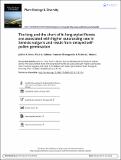The long and the short of it : long-styled florets are associated with higher outcrossing rate in Senecio vulgaris and result from delayed self-pollen germination
Abstract
Background: It has been reported that some plants of the self-compatible species, Senecio vulgaris, produce capitula containing long-styled florets which fail to set seed when left to self-pollinate, although readily set seed when self-pollinated by hand. Aims: To determine if production of long-styled florets is associated with higher outcrossing rate in S. vulgaris, and whether long-styles occur in non-pollinated florets, whereas short-styles are present in self-pollinated florets. Methods: The frequency of long-styled florets was compared in the radiate and non-radiate variants of S. vulgaris, known to exhibit higher and lower outcrossing rates, respectively. In addition, style length was compared in emasculated florets that were either self-pollinated or left non-pollinated. Results: Long-styled florets were more frequent in the higher outcrossing radiate variant. Following emasculation, long styles occurred in non-pollinated florets, while short styles were present in self-pollinated florets. The two variants did not differ in style length within the non-pollinated or within the self-pollinated floret categories. Conclusions: A high frequency of long-styled florets is associated with higher outcrossing rate in S. vulgaris and results from delayed self-pollination and pollen germination on stigmas.
Citation
Irwin , J A , Ashton , P A , Bretagnolle , F & Abbott , R J 2016 , ' The long and the short of it : long-styled florets are associated with higher outcrossing rate in Senecio vulgaris and result from delayed self-pollen germination ' , Plant Ecology & Diversity , vol. 9 , no. 2 , pp. 159-165 . https://doi.org/10.1080/17550874.2016.1181116
Publication
Plant Ecology & Diversity
Status
Peer reviewed
ISSN
1755-0874Type
Journal article
Description
The research reported in this article was funded in part by the Natural Environment Research Council under grants: GR3/6203A - Male competition and outcrossing rate in a hermaphrodite plant. GR9/1782A – Genomic analysis of wild hybrid derivatives of Senecio squalidus x S. vulgaris using in situ hybridization.Collections
Items in the St Andrews Research Repository are protected by copyright, with all rights reserved, unless otherwise indicated.

